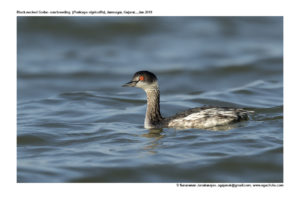Black-necked Grebe

Black-necked Grebe Podiceps nigricollis
Etymology:
- Podiceps : Latin word podicis – vent; pes -foot. { Legs are attached at extreme end of the body}
- Nigricollis : Latin word niger – black; collis –necked { Black necked}
Vernacular Names : Guj: Shyamagreeva dubki, Shiyalu nani dubki, Mar: Kalya manechi Tibukali
Distribution in India: Winter visitor in North West of India.
Description: Size of 28–34 cm; Wt. of 265–450 g. It has a distinctive i breeding plumage. It is the only grebe combining black head and neck, and yellow ‘ear-tufts’; bill looks slightly upcurved at tip; crown feathers are erectile, usually forming peaked profile, sometimes crest. The nominate race in breeding plumage has head, neck, breast and upperparts black to blackish brown, except conspicuous frayed fan of yellow to ochre feathers behind eye over ear-coverts . Sides of nape, foreneck sometimes largely tinged brownish; upperwing is blackish to drab brown, large white panel formed by secondaries and part of inner primaries. The sides and flanks are tawny rufous to maroon-chestnut with some blackish flecks, abdomen is white; underwing is white, except dark tertials and mostly pale grey-brown outer primaries. The iris is red with narrow paler and yellower inner ring, narrow bare orbital ring, orange-yellow to pinkish-red; bill is black; inconspicuous blackish line of bare skin connecting eye and gape. The legs are dark greenish grey. In non-breeding plumage it has greyish-black cap, nape and hindneck , greyish-black upperparts; dark colour of upper head extends to below eye and, diffusely, to ear-coverts, with white oblong on sides of neck behind ear-coverts. Rest of neck is grey to brownish grey with variable amount of white, white predominating on breast. It has a mix of blackish-grey and white flecking on sides and flanks with whitish abdomen. The bill is much greyer than in breeding plumage. Both the sexes are similar. The juvenile is like non-breeding adult, but dark areas usually more brownish, less black, often with pale grey tinge on lores, some whitish markings behind eye and buffy or tawny tinge on sides of head and upper neck; iris is initially duller.
Habitat: It is found in highly eutrophic ( Less oxygen) water bodies with lush vegetation, especially reedbeds, and typically with stretches of open water; occupies ponds, fish ponds, sewage farms and quiet river backwaters, also areas of lakes and marshes with suitable conditions It is found from sea-level to 3530 m.
Food habits :It eats insects, both adults and larvae, like aquatic bugs, terrestrial and aquatic beetles and damselflies and dragonflies. It also eats molluscs, crustaceans, amphibians and small fish. Food is usually obtained by diving It practices foliage-gleaning, and feeds more from water surface, picking objects off surface, submerging head while swimming, and occasionally capturing flying insects. It is found solitary, in pairs and in larger groups.
Breeding: They breed in Apr–Aug in Northern Hemisphere, Jan–Feb in East Africa and Oct–Apr in South Africa. Pair formation in the black-necked grebe usually starts during pauses in the migration to the breeding grounds. Courtship occurs when it arrives at the breeding lake. When advertising for a mate, a black-necked grebe will approach other black-necked grebes with its body fluffed out and its neck erect.The nest is a floating platform of plant material anchored to vegetation. They lay a clutch of 3–4 eggs. The incubation period is 20–24 days. Though the young can swim and dive during this time, they rarely do, instead staying on the parents’ backs for four days after hatching. After about 10 days, the parents split the chicks up, with each parent taking care of about half of the brood. After this split, the chicks are independent in about 10 days and fledge in about three weeks.
Moult and migration: When breeding is over, it usually partakes in a moult migration to saline lakes. It especially prefers lakes with large numbers of invertebrate prey, so that it can fatten up while moulting and before going on its winter migration. Some birds, although, moult when on the breeding grounds, but most do not moult until the end of the moult migration. This migration is dangerous, with hundreds and sometimes thousands of birds being killed by snowstorms when traveling to places. When it finishes its moult migration, this bird moults its remiges between August and September which makes it unable to fly. This moult is preceded by an increase in weight. During the moult, the breast muscles atrophy. When the moult is completed, it continues to gain weight, often more than doubling its original weight. This additional fat is used to power its overnight fall migration to its wintering grounds. The fat is most concentrated in the abdomen, second most in the thorax, and least in the chest. This bird usually starts its migration earlier when shrimp is more abundant and when the moulting lake is at a higher than average temperature. It generally leaves on a clear night with lower than average surface temperatures